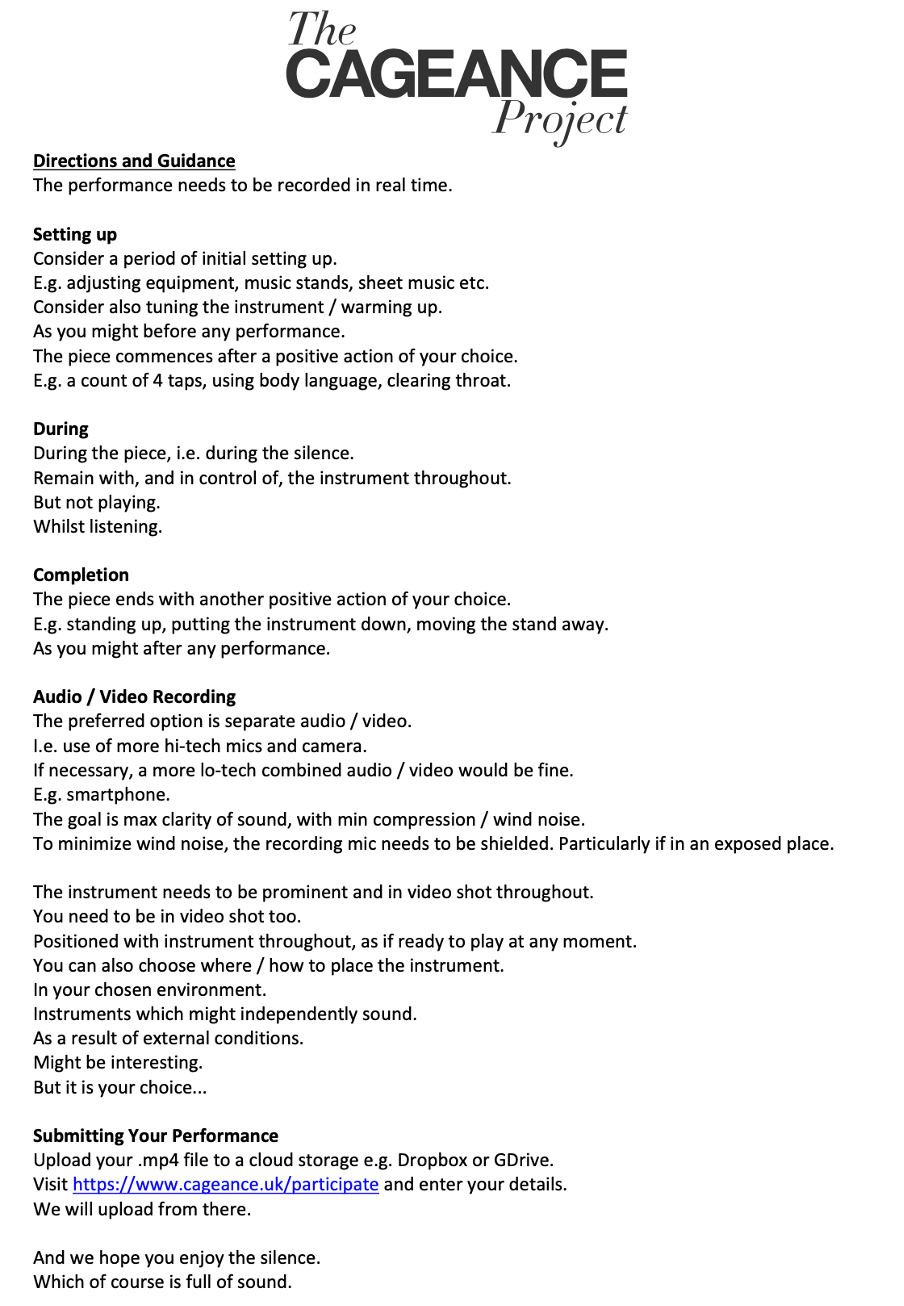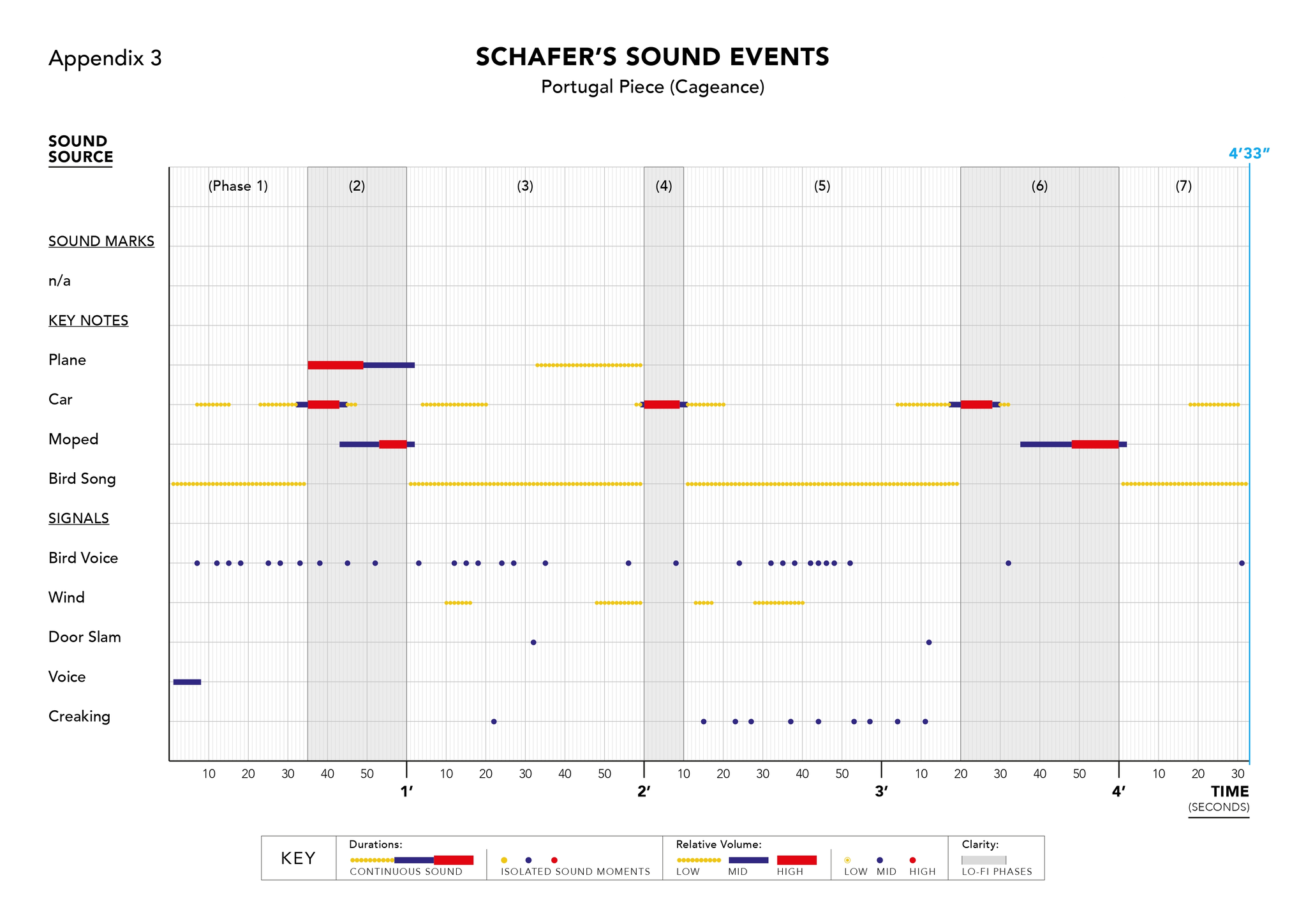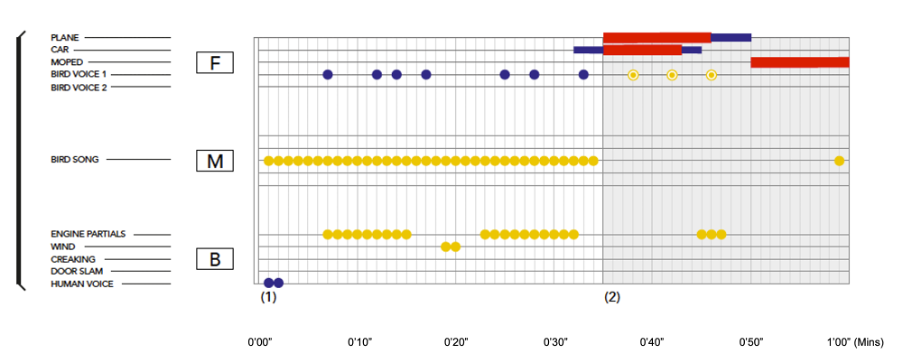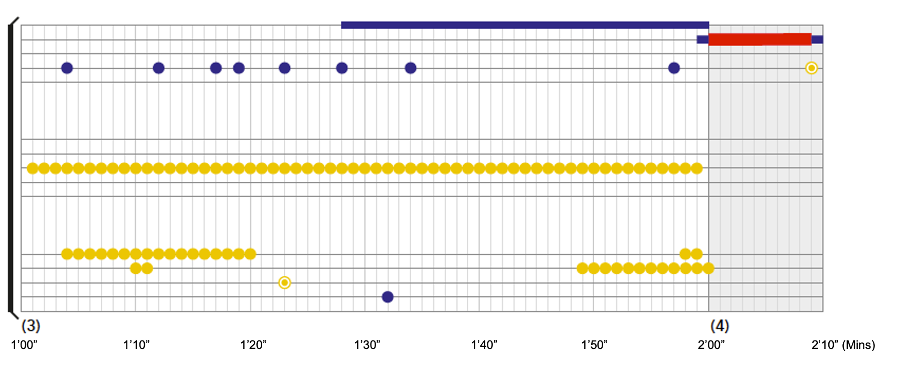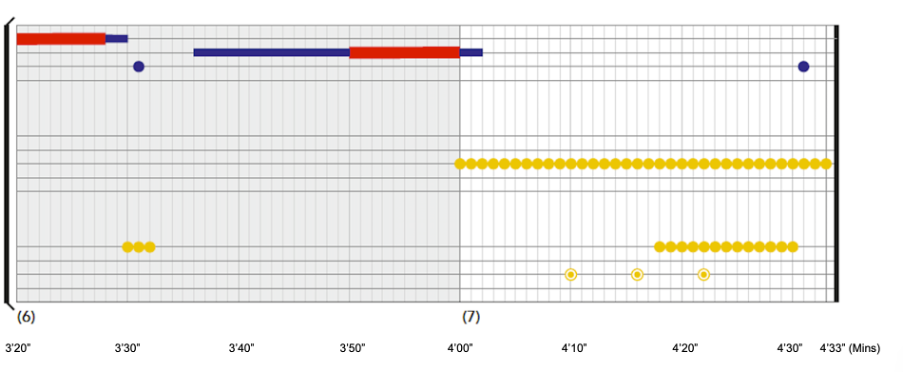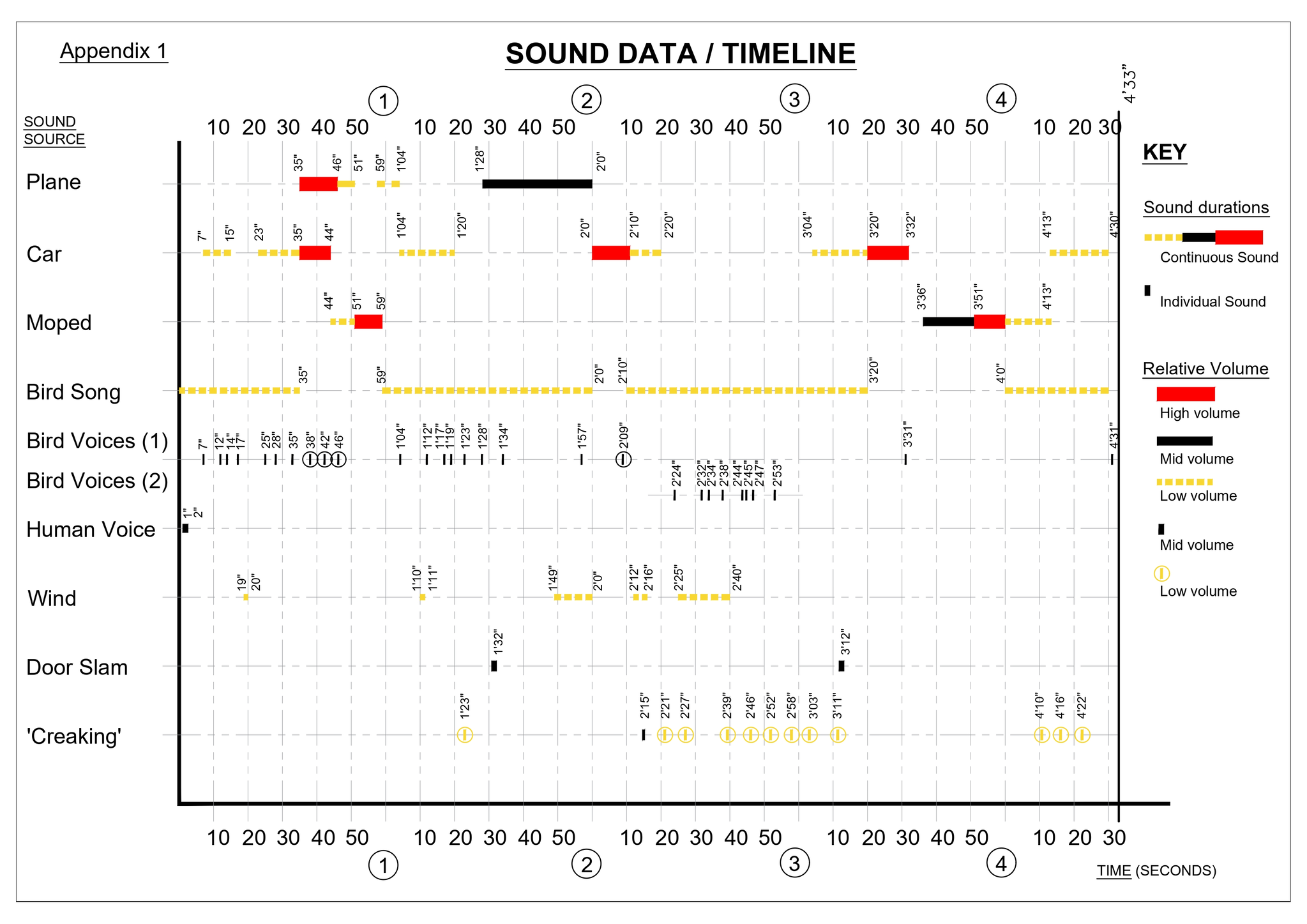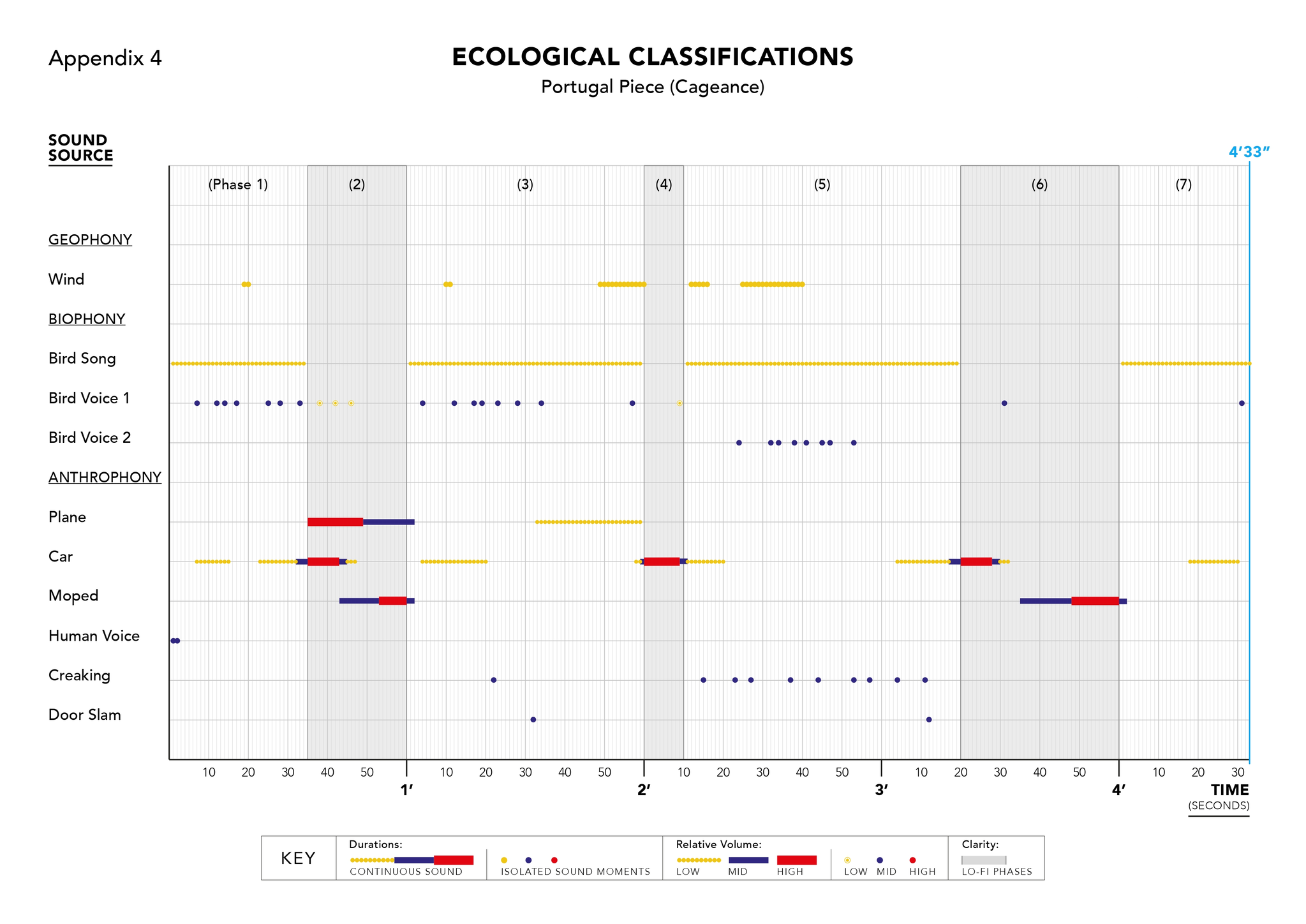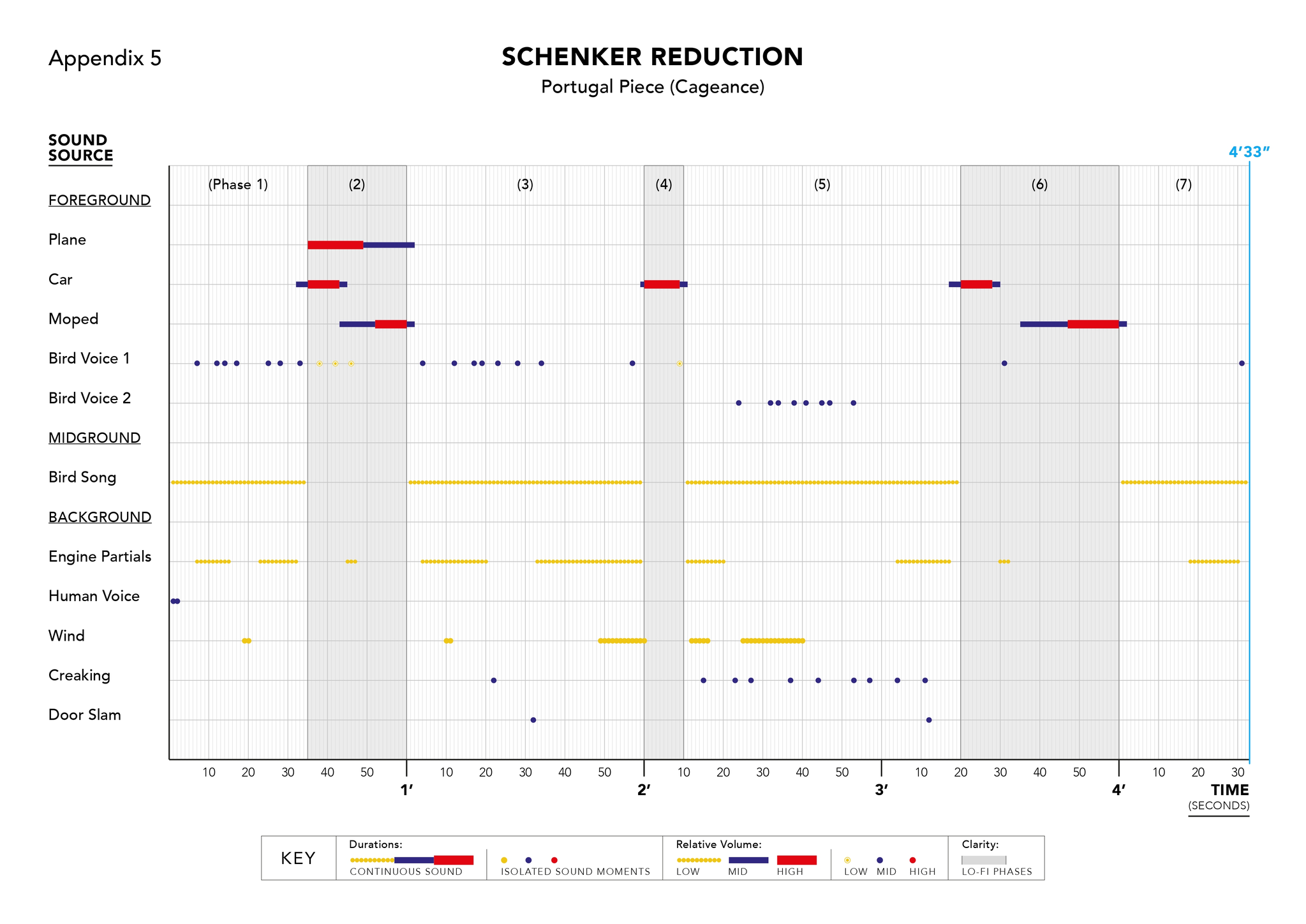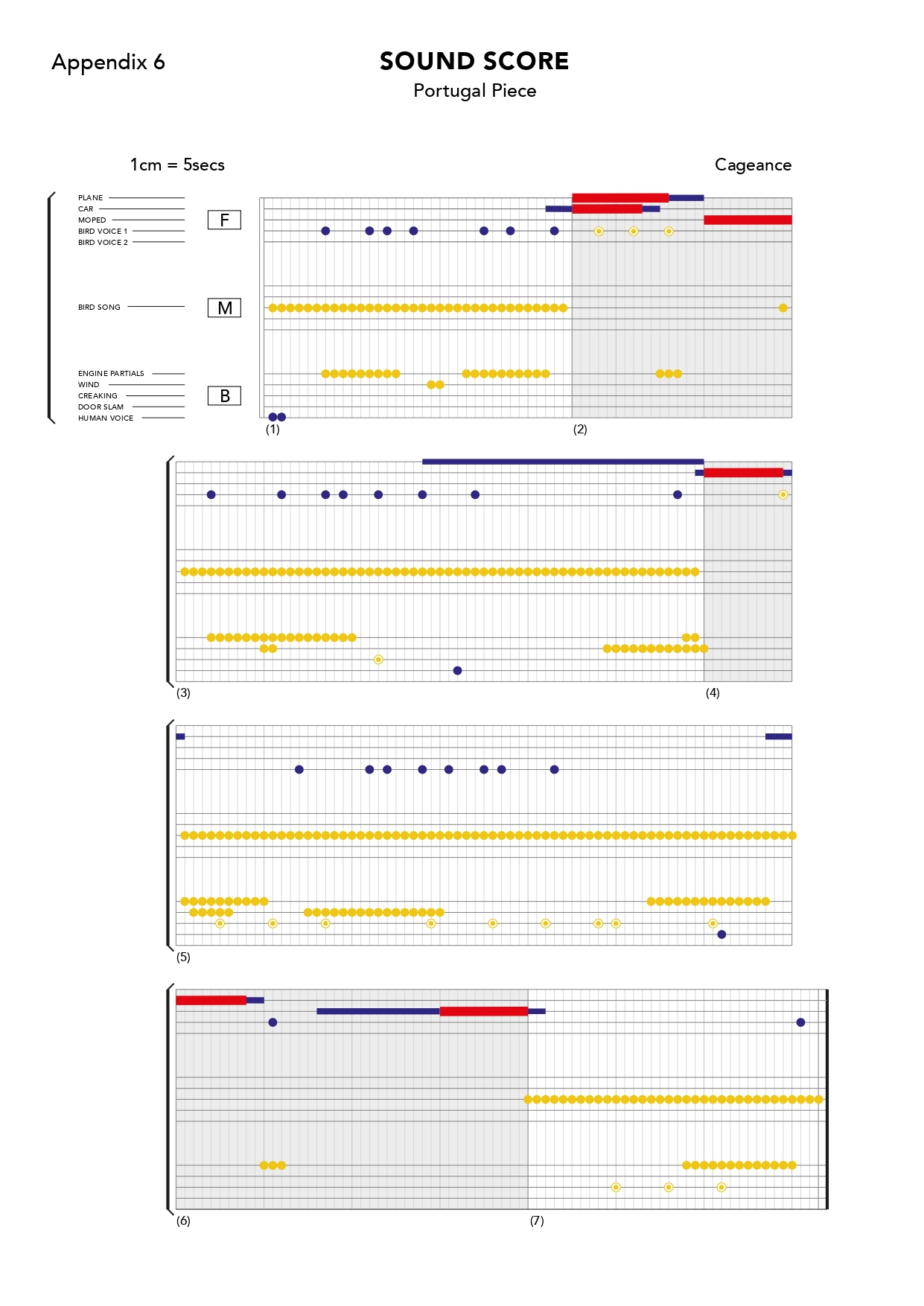Contents
1. Introduction
2. Context
2.1. Cageance
2.2. Limitations
2.3. Schafer
2.4. Music and Drama
3. Methodology
4.1. Schaferian Analysis
4.2. Musical Analysis
4.3. Dramatic Analysis
5. Conclusions
Appendix 1. Sound Data / Timeline
Appendix 2. Visual Sound Events
Appendix 3. Schafer Sound Events
Appendix 4. Ecological Classifications
Appendix 5. Schenker Reduction
Appendix 6. Sound Score (Portugal Piece)
___________________________
1. Introduction
This work takes the form of an exposition, as defined by the Journal for Artistic Research, staging and reflecting research through the layered presentation of practice and analytical interpretation. It is based on a performance from Cageance (Slater, 2020), a collaborative website-based composition that extends John Cage′s 4′33″ (1952), particularly Cage′s notion of intended silence as a means of ‘musicalizing’ ambient sound (Gann 2011: 11). The research explores musically framed silence not as absence, but as an active compositional medium, assessed through a synthesis of independent theoretical strands, resulting in what Weiss (2014: 511) identifies as a hybrid analytical approach. The exposition proposes that silence, as structured through Cagean practice, can function not only as ecological and musical compositional matter but as dramatic narrative, thereby reontologizing ambient sound as epistemologically rich.
Rooted in practice, this work combines creative output with reflective analytical methods. Murray Schafer′s soundscape theories form the initial point of inquiry, followed by two further strands: one that interprets chance-emergent ambient sound using conventional musical analysis, and another that examines the dramaturgical potential of the soundscape, considering how aleatory sonic events may unfold in relation to narrative, character, and cohesion.
The multimodal framework comprises three interconnected approaches:
- ′Schaferian’ Analysis: Investigating the interaction between environmental sounds in terms of soundmarks, signals, and keynotes, plus broader ecological reference ‘biological (biophony), geophysical (geophony), and human-produced (anthrophony) sounds’ emanating from landscapes, creating ‘unique acoustical patterns’ (Pijanowski and others 2011: 203).
- ‘Musical’ Analysis: Attributing conventional musical terms and characteristics to chance-emergent environmental sounds, encompassing Schenkerian layer reduction principles and advancing the conclusion of Deng, Kang and Wang (2015: 5) that ‘soundscape composition has its own musical features, musical functions, musical types and connections to other music genres.’
- ‘Dramatic’ Analysis: Starting from Longley’s (2019) definition of ‘drama’ as ‘fictional or nonfictional events through the performance of written dialogue’, the analysis seeks to investigate whether the soundscape is capable of constituting the dramatic narrative in itself.
This framework allows silence not just to be analysed but staged as research through ecological, musical, and dramaturgical lenses.
2. Context
Unlike traditional musical analysis, none of the above routes travel ‘forward,’ commencing from the basis of a score, assessing conventionally ‘composed’ musical outcomes, presented via intended ‘performers,’ using specified ‘instruments.’ Instead, this exposition is a retrospective exploration of chance-generated environmental sound objects. This requires justification. In many ways, the study is offering a solution to a problem, namely if 4′33″ is the revealing of (Cox and Warner 2017: 27) musically ‘curated’ ambient sound, performed in a musical space, Cageance formally externalizes this scope. It takes Cage′s chance-operations—the ‘ever-greater unpredictability to emerge within predefined limitations’ (Díaz 2014: 57)—into the reaches of interminable environmental milieu. This permits more extensive analysis of soundscape ecology in a musical context.
The term ′soundscape’ was first coined by Michael Southworth in The Sonic Environment of Cities (1969), developed by Schafer on the basis noise pollution is ‘now a world problem’ (1994: 3), and elaborated by Pijanowski and others (2011: 203) as ‘the relationship between a landscape and the composition of its sound.’ Accordingly, when considering whether music is part of a soundscape—or indeed amounts to the soundscape, two helpful references are 1) Akiyama, positing that Cage opened up music into an ‘emancipatory endgame’ (2010: 54), and 2) Schafer, in recognizing ecological sound properties, characterizing natural sounds which ‘compose’ environmental music (Pijanowski and others 2011: 203).
More profoundly, Crooks notes Cage′s view: ‘In India they say: “Music is continuous, it is we who turn away” [...] all you have to do is pay close attention to the sounds around you’ (2011: 196). This essentially forms the basis of Schafer′s 1977 thinking, embracing Cage′s stance that the world is a ‘musical macrocosmic composition’ (Schafer 1994: 5). Interestingly, both Schafer and Cage (Montague 1985: 213) independently reference Thoreau′s Walden, an influential nineteenth-century work alluding to the sounds and sights of nature′s ‘inexhaustible entertainment’ (2014: 88).
In summary, this study adopts the premise that all sound is ‘music’, encapsulated in Cage′s own words (Cox and Warner 2017: 36): ‘Music is sounds […] heard around us whether we′re in or out of concert halls’.
2.1 Cageance
Cageance is an international collaboration composed by the author that combines new performances of 4′33″ from participants worldwide. Such performances may include any number or combination of instrumentalists, with no restrictions on instrumentation, and each rendition may last for any length of time, in keeping with Cage's open-ended conception of 4′33″. Two participants are randomly selected by the software and paired in adjacent frames on screen, as illustrated in Image 2. Each video loops for a duration of 4′33″, and since each participant's submitted performance video is of a different length, the two recordings may combine at different points as they independently loop.
The composition is iterative, with each successive participant increasing the uniqueness of the chance-determined paired combinations. Occasionally, an interlude may appear between or alongside participant performances, introducing additional variability and further reinforcing the role of chance operations in structuring the experience.
Cageance sheet music, performance guidelines, and uploading instructions are displayed below for reference (Images 3 and 4). In accordance with these instructions, performances are directed to take place in (Slater 2020) 'any outdoor location in any region, noisy or tranquil, visually active or still,' such stipulated externalisation reinforcing (Akiyama 2010: 54) an 'ontological link to the locale in which [sounds] are recorded,' effectively expanding the 'definition of music to include place.'
The project currently comprises twenty-seven participants from seventeen countries since 2020. Of these, Ângela Gomes (Portugal) was selected as representative in terms of length, sonic activity, and range of sound sources. The subject piece is performed in a semi-urban setting on a keyboard and is hereinafter referred to as Cageance Portugal.
Cageance can be accessed here: https://cageance.webflow.io/. (Note: For optimal experience, headphones are recommended; the website is best accessed on tablet or desktop devices.)
Cageance Portugal can be viewed in the video below.
2.2 Limitations
At this stage, it is worth outlining what the analysis cannot achieve, summarized as judgments arising from:
- A more scientifically oriented quantitative approach, such as relating to decibel levels or pitch frequencies.
- Use of visual data representation through, for example, spectrograms or sonograms showing pitch frequency or amplitude.
- Use of ′sophisticated’ equipment such as automated digital recording systems or digital acoustic recorders to store timings and intensities of detected sounds. Quality of sound is, therefore, unable to be scrutinized at, for example, a granular level.
I would suggest that future analyses of such Cageance or similar soundscape pieces in the absence of these limitations would be worthwhile.
2.3 Schafer
In turning to Schafer, the question arises as to whether his standpoints, relating to acoustic design in community settings, can be used as an analytical tool in the first instance. Pierre Boulez, as quoted in Dunsby and Whittall (1988: 3), defines music analysis as a method requiring ‘each observation possible of the musical facts confronting us’. Cook (1994: 1) pertinently adds that it is the process of examining pieces of music to discover, or decide, how they work. As such, these elucidations do not preclude the basis for proceeding.
Schafer is principally concerned with a lack of awareness shown to acoustic surroundings (1994: 4), his position best presented as a dichotomy (1994: 5), namely, is ‘the soundscape of the world an indeterminate composition over which we have no control, or are we its composers and performers, responsible for giving it form and beauty?’. He takes the view that society is afflicted with noise pollution which ‘nature has thrown back […] forc[ing] us to listen again,’ (Krause, 1987: 14) an outlook that he fed into the 1970s World Soundscape Project (Akiyama 2010: 54)—indeed, to whom he dedicates his 1977 publication. More generally, Schafer′s work is integral to the advent of ‘Soundscape Ecology’ and ‘Acoustic Ecology’ (Pijanowski and others 2011: 204), and his impact has continued into more recent times, for example, The Positive Soundscape Project (2006), incorporating artistic and ethnographic conceptions of the soundscape (Davies and others 2007).
Saliently, Schafer (1994: 131) describes ‘soundscape’ as the interaction of ′sound events’, explaining that listeners focus on associative meanings relative to location in terms of (1994: 9) ′soundmarks’, ′signals’ and ‘keynotes’:
- Soundmarks. Derived from ‘landmark,’ soundmarks represent uniqueness in community environments, such as church bells. In other words, every natural soundscape has its characteristic tones and once identified, soundmarks ‘deserve to be protected’ (1994: 10).
- Signals and Keynotes. Schafer defines ‘signal’ (1994: 10) as sound to which attention is particularly directed, or ‘sounds listened to more consciously.’ Conversely, he delineates ‘keynotes’ (1994: 9) as those which identify the ‘tonality of a particular composition’, the ‘geography and climate, water, wind, forests, plains, birds, insects and animals’ (1994: 9–10). For Schafer, signals and keynotes contrast in much the same way as ‘figure and ground are contrasted in visual perception’ (1994: 275).
2.4 Music and Drama
The role of music as an accompaniment to drama is well established, exemplified by Brown (2007), who observes that it ‘heightens emotion, reinforces dramatic action, evokes atmosphere and mood in ways that words alone cannot.’ Deng, Kang and Wang extend this idea, recognizing more fundamentally that ‘auditory events’ can be ‘conceptualized as carriers of communicative information’ (2015: 4), which, in essence, supports my supposition that the soundscape could replace dialogue—an alternative communication form—becoming the drama. Of course, traditional stage play dramatic analysis is also well-developed, as seen in works by Beckerman (1971) and Cardullo (2015), and dramatic analysis of conventional music is likewise not new, as evidenced by studies such as those by Newcomb and Levinson (Levinson 2004) and Maus (1988, 1991, 1997). Maus adds (1988: 73), ‘Tovey is perhaps the most obvious example of a major analyst who explains music by providing a dramatic narrative.’ Therefore, this study explores the less extensively researched vantage of applying dramatic analysis to chance-based environmental soundscapes, uniquely positioning Cagean ambience as a revelation of its latent capacity for structure, characterisation, and tension.
3. Methodology
First, the sound data from Cageance Portugal is presented visually in Appendices 1–6 and forms the basis of the investigation. The format and content of such visual data stem from the research of Deng, Kang, and Wang (2015), who also cite Bishop and Sonnenschein′s ‘sound chart’ (2014), which similarly presents simultaneous sound events, timelines, and native locations in principle (Figures 1 and 2).
My appendices seek to present sound data differently from how we hear the sounds:
- Appendix 1 plots Cageance Portugal's sound sources against its timeline, with each source attributed to relative low, mid, and high volumes. All data per source is plotted along what I term its soundline.
- Appendix 2 presents this information without the timings, allowing for easier visual comparison and serving as the basis for subsequent assessment.
- Appendix 3 and Appendix 4 reorganize the data, creating the foundation for a Schaferian analysis, attributing soundmarks, keynotes, signals, and examples of biophony, geophony, and anthrophony. From this, it is possible to establish themes, features, and relationships between environmental sound objects from these perspectives. Such designations are distinct, underscoring the absence of hierarchy and challenging traditional musical or dramatic structures by conveying that no environmental sound object holds greater compositional or narrative weight than another.
- Appendix 5 presents an analysis of the sound data through the application of conventional musical characteristics. It centres on Schenker's separation of the Ursatz (fundamental structure) into foreground, middle, and background layers, establishing the principle of Urlinie (fundamental line), and underpinned by supporting lines (Cook 2002: 41). At first glance, this may appear to be an extreme application of Schenker's theory. It is also worth acknowledging that recognition of the limitations of Schenkerian analysis is not new. For example, Gallardo (2000) explains that Schenker only analyzed 18th- and 19th-century German music, yet assumed his theory had universal applicability. In addition, Forte, as cited in Maus (1988: 56), critiques the absence of a 'theory of rhythm' in such tonal music, lamenting Schenker's limited repertoire. However, while these limitations are important to be aware of, I argue that this novel application of Schenkerian analysis remains useful here, as its emphasis on structure and underlying patterns offers a useful basis for identifying and interpreting musical characteristics within ambient sound.
- Appendix 6 extends the Schenkerian analysis to a proposed method for 'notating' emergent environmental sound in a more musically conventional format. Schafer (1994: 123) describes notation, simply, as an attempt to render aural phenomena through visual signs, and in establishing greater musical correlation with Cagean ambience, it indeed becomes feasible to convert Schenkerian reduction into a 'musical' score. This final appendix, therefore, includes the upper stave (foreground), mid-stave, and lower stave (background), with all three brackets denoting the full extent of the sound source's‘ instrumentation.' I propose the term' sound score' to describe this method of notation.
The final part of the analysis appraises environmental sound in a dramatic context, as an alternative' embodiment of meaning and a mode of communication' (Beckerman 1971: 403). To achieve this, I will apply Lethbridge and Mildorf′s summarized features of staged drama (2003: 90), and Maus′s stage play properties (1988: 72), giving attention to the scope for dramatic 'tension' and 'anticipation' in ambient sound.
Through such notational and analytical innovations, this research develops new tools for understanding the sound embedded within Cagean 'silence'.
Observations
- Soundmarks: The semi-urban setting may reasonably be described as nondescript owing to the absence of a unique soundmark. This said, given the mesoscale timeframe (Roads 2004), it may equally be due to a lack of opportunity for such identity-characterizing sounds to be heard. Within the 4′33″ duration, however, no soundmarks were recorded. This absence becomes meaningful, underlining the Cagean notion of environmental sound as a constantly evolving composition rather than a fixed one.
- Keynotes: In contrast, continuous birdsong, plane, cars, and moped are keynotes. Being synonymous with Portuguese culture (Blackman and Haworth 2010), mopeds offer possible soundmark qualities but arguably predominate in wider geography than the smaller scale analysed here. Nevertheless, their presence helps to anchor the locale, contributing to Akiyama’s (2010: 54) earlier suggestion that music can be extended ontologically to include 'place.'
- Signals: Similarly, numerous signals exist, including Ângela Gomes′ throat-clearing (0’02″), door slams (1’32″, 3’12″), a succession of ‘creaking’ sounds (notably 2’15″–3’11″), and individually discernible bird voices (first three minutes in particular). The intermittency of signals—and indeed keynotes—introduces a periodic tension that both disrupts and enlivens the continuity of the soundscape.
- ‘Lo-fi’ Sound: Schafer defines low lo-fi as an ‘unfavourable’ signal-to-noise ratio, where sound is ‘overcrowded,’ resulting in a lack of clarity (1994: 272). Conversely, ‘hi-fi’ is clearly heard sound (1994: 272) where ‘esteemed sounds can be readily auditioned’ (McKinnon 2013: 71). Consequently, the plane, cars, and moped sounds between 0′35″–0′59″, 2′00″–2′10″ and 3′20″–4′00″ interact to create lo-fi periods, shown as the grey-shaded areas in Figure 3. Of note, while Schafer considers lo-fi sounds unfavourable, they arguably serve the piece positively overall by heightening the relative ‘favourability’ of hi-fi periods, assisting the depth of experience through the dynamics of contrast and anticipation.
- Structure: Such lo-fi periods organise Cageance Portugal into seven phases, each containing the soundscape fluidity within fixed framing. In effect, such intervals work as natural dividing points (like musical phrases or dramatic scenes), giving a sense of overall shape.
Appendix 4 resequences the soundlines according to ecological classifications, namely, biophony, geophony, and anthrophony. Figures 4–6 display the resultant groupings, offering another perspective on the relationships between the sounds, followed by my accompanying observations below.
Observations
- Geophonous and biophonous sounds are restricted to keynotes and signals that are at most moderately loud, whereas anthrophony commands the most significant presence in both volume and duration. This reveals that human-generated sound dominates the soundscape, even in an outdoor location, accounting for twice as many sound sources as biophony and comprising the bulk of the resultant form. Interestingly, despite its external location, geophony plays a minimal role, pointing to an ecological imbalance in modern soundscapes.
- The seemingly overriding aural dominance of anthrophonous engine sounds creates lo-fi conditions for only 27% of the duration of the piece (1′14″ total), indicating that despite the prevalence of human sounds, they do not entirely obscure the structure or listenability of the soundscape.
- Individual foreground bird sounds are typically constant and can also be heard over engine sounds on occasion. This is possibly, at least in part, due to the birds’ proximity to the recording device. However, it arguably functions as ‘consonance’ within the lo-fi ‘dissonance’, not only analogously overlapping with musical qualities, but also highlighting interplay between seemingly stable keynotes and more variable anthrophony.
4.2 Musical Analysis
Shifting to musical form, Appendix 5 resequences the sound sources according to Schenkerian reduction principles, highlighting foreground engine sounds and individual bird voices, mid-layer continuous birdsong, and background wind, creaking, door slams, throat clearing, and low-volume engine sound ‘partials.’ Once again, focused appendix extracts are presented (Figures 7–9), with my corresponding reflections provided beneath. To facilitate a closer musical analogy, the seven phases of Cageance Portugal are hereafter also referred to as 'measures'.
Observations
- Both foreground and background layers contain ‘staccato’ and ‘legato’ interaction, namely short decay bird voices texturally alongside longer duration engine sounds; and longer engine partials alongside intermittent near-immediate decay human voice, wind, creaking and door slams. The mid-layer potentially serves as a continuous ‘pedal-point,’ which could be musically interpreted as mediating interaction between the adjoining layers (Figures 7–9).
- Although chance-generated sound might be expected to be arrhythmic, it is perhaps surprising to note the regularity of hi-fi and lo-fi measures, as well as the relative frequency of individual creaking sounds within measure 5, framed by door slams before and after. Furthermore, the repetition of individual bird voice phrasing in phases 1, 3, and 5 (see Figures 10–12) hints at anacrusis, each leading into the grey-shaded lo-fi.
Intriguingly, Appendix 6 evidences a particularly interesting parallel with Sonata form (Figures 13–16). A two-measure ‘exposition’ plausibly introduces the piece with bird voices (foreground), birdsong (mid), and low volume engine partials, wind and human voice (background), all leading into lo-fi (measure 2). Measures 3–4 ‘develop’ the piece with now settled foreground engine and repeated bird voice phrasing, plus background wind sounds, associated creaking and door slam; all leading into lo-fi (measure 4). Measures 5–6 evidence intensified development: greater background textural activity, leading into lo-fi (measure 6). ‘Recapitulation’ occurs in measure 7, alluding to what I would describe as an environmental tonic. Of course, it should be emphasized that the observation of a Sonata form analogy is purely heuristic—used to draw out interpretative structure where none is formally composed. However, it supports this research's broader proposition of this research that ambient sound can embody structured musical knowledge.
4.3 Dramatic Analysis
The final perspective assesses the soundscape as a form of drama. A useful starting point here is Lethbridge and Mildorf′s summary of dramatic features (2003: 90).
- Information flow
- Structure
- Space
- Time
- Characters
- Types of utterance
- Types of stage
Information flow arguably exists in terms of the sounds being the narrative, a notion that Maus (1991: 3) defines as ‘identifiable objects’ arranged in ‘partially predictable patterns.’ Structure is present through fixed framing, a demarcated timeline containing real time events; in Cageance Portugal′s case, it is systemized with hi-fi and lo-fi phases. Space, time and characters arguably occur through uninterrupted spatiotemporal conditions; the sound sources functioning as ‘instruments’ in a musical sense and ‘characters’ in a dramatic sense. Types of utterances can be seen as the varying form, lengths, tones and timbres produced by the characters. Types of stage are entirely mandated by the location decisions of Cageance participants, with Cageance′s ‘positive actions’ (Slater 2020) signifying the beginning and end of the piece—effectively raising and then lowering the stage curtain, with the camera serving as the proscenium arch.
From a different perspective, Maus (1988: 72) proposed four stage-play properties:
- A series of actions
- Performed by characters
- For an audience
- Forming a plot, holding the actions in a cohesive structure
It is difficult to argue against chance-resultant sounds equating to a sequence of actions, a view shared by Maus (1988: 67) who writes that in ‘listening to a piece, it is as though one follows a series of actions that are performed.’ The sound sources once more personify the characters of the play, with audiences perceiving them via Cageance′s audiovisual format. The plot comprises uninterrupted sequences of unfolding events, with cohesion formed in the built-up durations; and pertinently, Maus (1988: 72) suggests music structure is its own story, arguing (1991: 6) listeners hear ‘musical successions as story-like because they can find something like actions, thoughts, and characters.’
The significance of ‘perception’ also feeds into whether an audience can experience progressive tension and anticipation in a soundscape as the story unfolds (Longley 2019). Fonseca-Wollheim (2019) recognizes ‘the pregnant pause, the stunned silence, the expectant hush’, neatly exemplifying silence as anticipatory, creating expectation as to when and where subsequent sounds will occur. Kirpal Singh is quoted to explain (Schafer 1994: 259) that sound ‘passes from existent to nonexistent’, therefore ‘when there is no sound, hearing is most alert’. In turn, this connects to the role played by acousmatic listening, namely sound heard in the absence of its origin (Beard 2019: 129), which Chion (2009: 3) describes as ‘reduced listening,’ arguably assisting in anticipation and enhancing immersion into the soundscape experience. This is indeed borne out in Cageance Portugal; for example, is the plane sound (0′35″–1′04″) in fact a car? Is the wind causing the keyboard to creak?
5. Conclusions
Reflecting on the multimodal framework established earlier, comprising Schaferian, musical, and dramatic analysis, this work makes three key contributions:
First, it advances discourse stemming from Cage’s (McKinnon 2013: 71) repurposing of the intentional listening of music, Schafer’s ecological soundscape context, and Cageance’s formal externalisation of Cage’s musically framed 'silence' revealing environmental sound. Specifically, it introduces the use of a sound score employing soundlines to notate ambience, enabling new analysis techniques to be applied to sound data presented comparably to traditional music scores. Holistically, this approach enables the structured application of ecological classification and musical features, framing fluid environmental sounds within a fixed temporal structure.
Second, it argues for the validity of extending Cage’s redefinition of music and musical roles (2009: 11)—namely, the functions of composer, performer, instrumentation, and emergent form—into the arena of drama. Put differently, it suggests that ambient sound, as revealed, functions not simply as background, but as the narrative itself, with structure, tension, and character. This repositions Cagean ambience as an entity in its own right.
Third, the limitations of the study signpost further possibilities. For example, analysing a single Cageance submission from a fixed recording location yields only partial insight. The application of Schaferian thinking and ecological classification would likely benefit from larger-scale, macro- or supra-timeframe datasets. Therefore, a broader analysis across all Cageance participants may reveal more sustained patterns. Furthermore, additional philosophical inquiry—especially into Staten’s (2012) physis and Eikeland’s (2014) notions of techne, poiesis, and phronesis—may help deepen our understanding of non-human or indeterminate composition.
Finally, contrary to Cage’s aesthetic of sound as free from meaning (Cage 2009: 10), this work invites further inquiry into a relatively unexplored field—one which, as Westerkamp (1999: 2) writes, embodies a ‘desire for deeper knowledge and information about our own as well as other places and cultures.’
___________________________
Bibliography
Akiyama, Mitchell. 2010. ‘Transparent Listening: Soundscape Composition’s Objects of Study’, RACAR: Revue d'art canadienne, 35: 54–62
Beard, David. 2019. ‘Acousmatic Listening and a Critical Awareness of Place’, International Journal of Listening, 33: 129–32
Beckerman, Bernard. 1971. ‘Dramatic Analysis and Literary Interpretation: The Cherry Orchard as Exemplum’, Performances in Drama, the Arts, and Society, 2: 391–406
Bishop, Matthew J., and David Sonnenschein. 2014. ‘Designing with Sound: Four Recommendations from the Film Industry’, Journal of Applied Instructional Design, 2: 5–15
Blackman, R., and N. Haworth. 2010. ‘Implications for Safety and Planning of a Sharp Increase in Moped and Scooter Use’, International Conference on Safety and Mobility of Vulnerable Road Users (Jerusalem)
Brown, Larry. 2020. ‘The Dramatic Function of Songs in Musical Theater’, Larry Avis Brown https://larryavisbrown.com/dramatic-function-of-songs-in-musicals/ [accessed 22 May 2025]
Cage, John. 2009. Silence (London: Marion Boyars Publishers Ltd)
Cardullo, Robert. 2015. Play Analysis: Casebook on Modern Western Drama (Sense Publishers)
Chion, Michel. 2009. The Three Listening Modes
Cook, Nicholas. 2002. A Guide to Musical Analysis (New York: Oxford University Press)
Cox, Christopher, and Daniel Warner. 2017. Audio Culture (London: Bloomsbury Academic)
Crooks, Edward. 2011. John Cage's Entanglement with the Ideas of Coomaraswamy (Unpublished doctoral thesis, University of York)
Davies, William, and others. 2007. ‘The Positive Soundscape Project’, 19th International Congress on Acoustics
Deng, Zhiwei, Jian Kang, and Dong Wang. 2015. ‘Soundscape Composition as a Distinct Music Genre’, International Conference on the Multimodal Experience of Music, Sheffield, 23–25 March
Díaz, Eva. 2014. The Experimenters (Chicago: University of Chicago Press)
Dunsby, Jonathan, and Arnold Whittall. 1988. Music Analysis in Theory and Practice (London: Faber)
Eikeland, Olav. 2014. ‘Techne’, ResearchGate, 1–4
da Fonseca-Wollheim, Corinna. 2019. ‘How the Silence Makes the Music’, The New York Times, 2 October https://www.nytimes.com/2019/10/02/arts/music/silence-classical-music.html [accessed 22 May 2025]
Gallardo, Carlos. 2000. ‘Schenkerian Analysis and Popular Music’, Trans, 5
Gann, Kyle. 2010. ‘No Such Thing as Silence’, American Music, 28: 504–07
Krause, Bernie. 1987. ‘Bioacoustics, Habitat Ambience in Ecological Balance’, Whole Earth, 57: 14–18
Lethbridge, Stefanie, and Jarmila Mildorf. 2003. Basics of English Studies: An Introductory Course for Students of Literary Studies in English
Levinson, Jerrold. 2004. ‘Music as Narrative and Music as Drama’, Mind & Language, 19: 428–41
Longley, Robert. 2021. ‘What Is Drama? Literary Definition and Examples’, ThoughtCo https://www.thoughtco.com/drama-literary-definition-4171972 [accessed 22 May 2025]
Maus, Fred. 1988. ‘Music as Drama’, Music Theory Spectrum, 10: 56–73
Maus, Fred. 1991. ‘Music as Narrative’, Indiana Theory Review, 12: 1–34
Maus, Fred. 1997. ‘Narrative, Drama, and Emotion in Instrumental Music’, Journal of Aesthetics and Art Criticism, 55: 293–303
McKinnon, Dugal. 2013. ‘Dead Silence: Ecological Silencing and Environmentally Engaged Sound Art’, Leonardo Music Journal, 23: 71–74
Montague, Stephen. 1985. ‘John Cage at Seventy: An Interview’, American Music, 3: 205–16
Pijanowski, Bryan, and others. 2011. ‘Soundscape Ecology: The Science of Sound in the Landscape’, BioScience, 61: 203–16
Roads, Curtis. 2004. Microsound (MIT Press)
Schafer, R. Murray. 1994. The Soundscape: Our Sonic Environment and the Tuning of the World (Rochester, VT: Destiny Books)
Slater, Stuart. 2020. The Cageance Project https://cageance.webflow.io/ [accessed 22 May 2025]
Southworth, Michael. 1969. ‘The Sonic Environment of Cities’, Environment and Behavior, 1: 49–70
Staten, Henry. 2012. ‘The Origin of the Work of Art in Material Practice’, New Literary History, 43: 43–64
Thoreau, Henry. 2014. Walden (CreateSpace Independent Publishing Platform)
Weiss, Sarah. 2014. ‘Listening to the World but Hearing Ourselves: Hybridity and Perceptions of Authenticity in World Music’, Ethnomusicology, 58: 506–25
Westerkamp, Hildegard. 1999. ‘Soundscape Composition: Linking Inner and Outer Worlds’, Soundscape, 1–4



